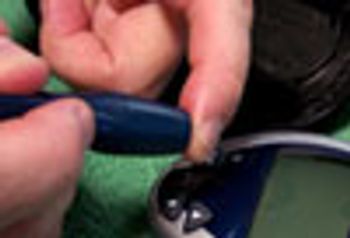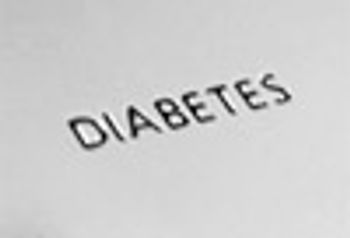
The patient, an active 49-year-old man, had an HbA1c of 8.6 after diabetes was first diagnosed. It’s now 7.6 with metformin and lifestyle measures. Is the current A1c goal adequate, or should you treat more aggressively?

The patient, an active 49-year-old man, had an HbA1c of 8.6 after diabetes was first diagnosed. It’s now 7.6 with metformin and lifestyle measures. Is the current A1c goal adequate, or should you treat more aggressively?

Hypoglycemia in type 2 diabetes patients can be the result of insulin or sulfonylureas.

Reducing hyperglycemia in older patients with chronic kidney disease may be best accomplished using incretin-based agents.

Hypertension is very common in people with diabetes; in this patient’s case, it may have been present for 5 to 10 years before the hyperglycemia appeared.

In addition to lifestyle changes, how would you treat this patient?

Blood sugar and HbA1C are very high; how would you treat this patient's hyperglycemia?

The elderly patient has had type 2 diabetes for 15 years is now home bound after a stroke. Her HbA1c is 9.6 and she takes only metformin. Review the rest of her laboratory results and propose a management plan.

Would you treat the elevated A1C aggressively-and what would your target level be? Would you consider statins? Dr Shahady invites your insights.

Do you consider an LDL of 100 and a non-HDL of 150 significant? What is your diagnosis? Would you consider medication in addition to recommending lifestyle changes? Answers to these quiz questions here.

A 47-year-old man sees you for a check-up. He complains only of low energy and attributes it to recent weight gain. But, there is much more.

Over the past 4 decades, our understanding of the role of elevated cholesterol in cardiovascular disease (CVD) has undergone radical change. During that time, we have moved from a belief that cholesterol does not matter and that atherosclerosis is an irreversible process to a strong conviction that treating elevated cholesterol, especially elevated low-density lipoprotein cholesterol (LDL-C), can slow and perhaps halt the progression of atherosclerosis. But it has been a slow process for several reasons. In the 1960s, the Framingham investigators demonstrated that elevated serum cholesterol is a risk factor for CVD.1

As many as 10% of Americans older than 20 years have type 2 diabetes, and more than 20% of the total population has the metabolic syndrome. Type 2 diabetes will develop in many of those with the metabolic syndrome.

As the numbers of patients with diabetes continue to climb, physicians and health policy experts are devoting increasing attention to strategies that can improve care for these patients. One of the strategies frequently mentioned is the Chronic Care Model, developed in 1998 by the MacColl Institute for Healthcare Innovation.

A 38-year-old secretary has had right wrist pain for the past 6 months. It was initially relievedby ibuprofen but is now persistent and makes it difficult for her to type. The pain is worse atnight.

During a routine diabetes follow-up visit, a 55-year-old man complains of increasing pain in his right groin and hip. He is also being treated for hypertension, and his body mass index is 28.

A 34-year-old man has had bilateralknee pain for the past 16 months andbilateral hip pain for the past 8 months.The pain is exacerbated by running, byweight bearing, and recently even by sittingfor extended periods. Moving froma sitting to a standing position is especiallydifficult. A week earlier, he visitedan urgent care center and was given naproxen and a 7-day course of prednisone,but neither medication alleviatedthe pain; in fact, he now feels worse.

A 16-year-old boy presents with severe left shoulder pain that began 20 minutes earlier when heslipped while walking down an incline and attempted to prevent a fall by grabbing a nearby structurewith his left hand. As his body went forward, the left shoulder was abducted and externallyrotated. The accident caused him immediate pain, and any subsequent movement of the injuredshoulder increases the pain. Previously, the patient was healthy.

A 24-year-old man seeks medical attention 3 weeks after he injured his little finger playingfootball. He reports that the finger “came out of place” at the middle knuckle (proximal interphalangeal[PIP] joint); he quickly put the finger back into place himself, quit playing, andiced it. About 2 hours later, he was unable tomove the finger without significant pain, andthe following day, inability to move it interferedwith his performance of tasks that requiredfine manual dexterity. Since then, thepain has decreased, but the finger remainsswollen and he has not been able to fully extendit at the middle knuckle. In addition, thetip of the injured finger is hyperextended.

A 42-year-old man complains of persistent right shoulder pain that for the past 6 months hasprevented him from participating in his usual weight-lifting routine and affected daily activities.He is able to comb his hair and scratch his back with his right hand with no increase in pain, butreaching across his body causes discomfort. NSAIDs provide only modest relief.

A healthy 11-year-old boy complains of a “bump below his kneecap” that hurts to touch and whenhe jumps. He first felt slight pain a month earlier. Since then, he has occasionally complained ofpain and a bump on the right knee.

A 23-year-old man complains of looseness, clicking, and intermittent soreness in his right knee.In addition, the knee locks for short periods, and he has an occasional shooting pain up his rightthigh that causes the knee to buckle when he is walking. These symptoms have occurred intermittentlyover the past year, along with periods when the knee functions normally.

A 17-year-old girl who is a competitive cross-country runner presentswith exercise-induced pain in the lower left leg that hasbeen present for 2 months. She describes the pain as a feelingof tightness that begins after 20 to 30 minutes of running; thistightness usually resolves within 15 to 30 minutes after shestops. During the past 3 weeks, the tightness has been accompaniedby a cramp-like pain. The patient runs before and afterschool about 12 miles each day. In addition to running, she hasalso begun playing flag football during the past 2 weeks. She isotherwise in good health.

A 36-year-old man complains of right foot pain of several months' duration that limits his ability to run. He has been able to keep running by icing the foot and by stopping his running program for a few days when the pain increases.

A 48-year-old woman complains of finger and knuckle pain in her right hand of 1 year's duration. She is right-handed. The pain is located over the metacarpophalangeal (MCP) and proximal interphalangeal (PIP) joints of the index and middle fingers.

ABSTRACT: Our knowledge of chronic diseases has advanced significantly in recent decades, but patient outcomes have not kept pace. This is largely because the traditional acute care model does not adequately address the needs of patients with chronic disease. Patients play an active role in the management of chronic disease, and successful outcomes are highly dependent on adherence to treatment. Thus, clinicians need to have skills in coaching and encouraging as well as an awareness of factors in patients' backgrounds that are likely to affect their ability or willingness to follow treatment plans. Provider- and system-related factors, such as lack of reimbursement for counseling and high copayments, can also act as barriers to compliance. Among the strategies that can improve adherence are the use of community resources, multidisciplinary approaches, and regular follow-up.

Over the past few decades, the management of chronic disease has assumed a greater role in health care. Diseases such as diabetes, chronic obstructive pulmonary disease, and depression have replaced acute disorders as the leading cause of morbidity, mortality, and health care expenditures.

A 16-year-old boy complains of right lower leg pain that began after his first week at a summer basketball conditioning camp. Before he left for the camp, he was jogging off and on, averaging a few miles a week.

A 17-year-old boy landed with most of his weight on his plantar-flexed right foot during a skateboarding accident. He felt pain on the top of his right foot and could not bear weight on it.

A 16-year-old football player complains of increasing pain in the ring finger of his right hand. It began 2 days earlier, when he tried to tackle a running back by grabbing the player's jersey; he felt immediate pain and was unable to continue holding on to the jersey.

A 12-year-old girl complains of left knee pain and swelling that resulted from a collision with another player while she was playing kickball the day before. Her left foot was planted as she tried to catch a ball, and she was hit on the outside of the left knee.

Published: April 2nd 2008 | Updated:

Published: April 2nd 2008 | Updated:

Published: September 2nd 2008 | Updated:

Published: July 26th 2012 | Updated:

Published: September 28th 2012 | Updated:

Published: September 1st 2006 | Updated: